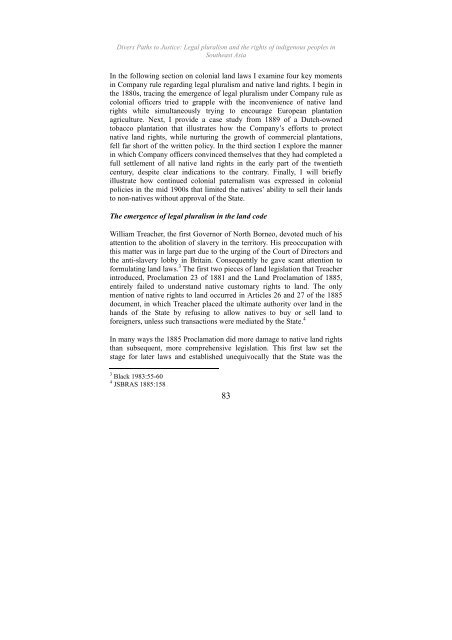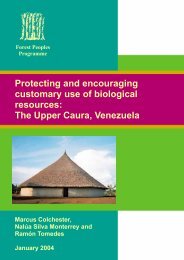Divers Paths to Justice - English - Forest Peoples Programme
Divers Paths to Justice - English - Forest Peoples Programme
Divers Paths to Justice - English - Forest Peoples Programme
Create successful ePaper yourself
Turn your PDF publications into a flip-book with our unique Google optimized e-Paper software.
<strong>Divers</strong> <strong>Paths</strong> <strong>to</strong> <strong>Justice</strong>: Legal pluralism and the rights of indigenous peoples inSoutheast AsiaIn the following section on colonial land laws I examine four key momentsin Company rule regarding legal pluralism and native land rights. I begin inthe 1880s, tracing the emergence of legal pluralism under Company rule ascolonial officers tried <strong>to</strong> grapple with the inconvenience of native landrights while simultaneously trying <strong>to</strong> encourage European plantationagriculture. Next, I provide a case study from 1889 of a Dutch-owned<strong>to</strong>bacco plantation that illustrates how the Company’s efforts <strong>to</strong> protectnative land rights, while nurturing the growth of commercial plantations,fell far short of the written policy. In the third section I explore the mannerin which Company officers convinced themselves that they had completed afull settlement of all native land rights in the early part of the twentiethcentury, despite clear indications <strong>to</strong> the contrary. Finally, I will brieflyillustrate how continued colonial paternalism was expressed in colonialpolicies in the mid 1900s that limited the natives’ ability <strong>to</strong> sell their lands<strong>to</strong> non-natives without approval of the State.The emergence of legal pluralism in the land codeWilliam Treacher, the first Governor of North Borneo, devoted much of hisattention <strong>to</strong> the abolition of slavery in the terri<strong>to</strong>ry. His preoccupation withthis matter was in large part due <strong>to</strong> the urging of the Court of Direc<strong>to</strong>rs andthe anti-slavery lobby in Britain. Consequently he gave scant attention <strong>to</strong>formulating land laws. 3 The first two pieces of land legislation that Treacherintroduced, Proclamation 23 of 1881 and the Land Proclamation of 1885,entirely failed <strong>to</strong> understand native cus<strong>to</strong>mary rights <strong>to</strong> land. The onlymention of native rights <strong>to</strong> land occurred in Articles 26 and 27 of the 1885document, in which Treacher placed the ultimate authority over land in thehands of the State by refusing <strong>to</strong> allow natives <strong>to</strong> buy or sell land <strong>to</strong>foreigners, unless such transactions were mediated by the State. 4In many ways the 1885 Proclamation did more damage <strong>to</strong> native land rightsthan subsequent, more comprehensive legislation. This first law set thestage for later laws and established unequivocally that the State was the3 Black 1983:55-604 JSBRAS 1885:15883
















